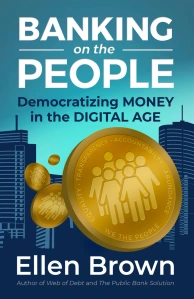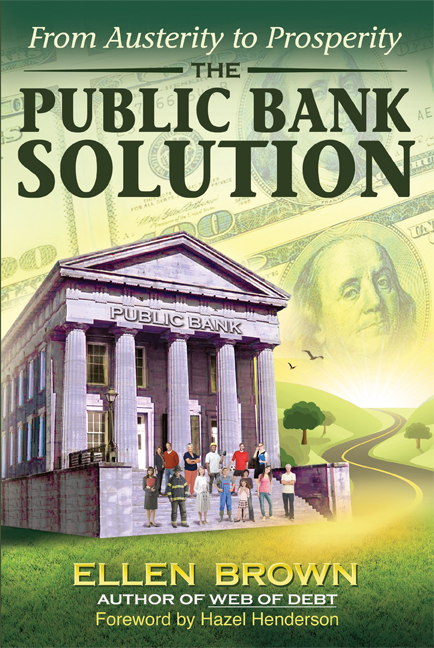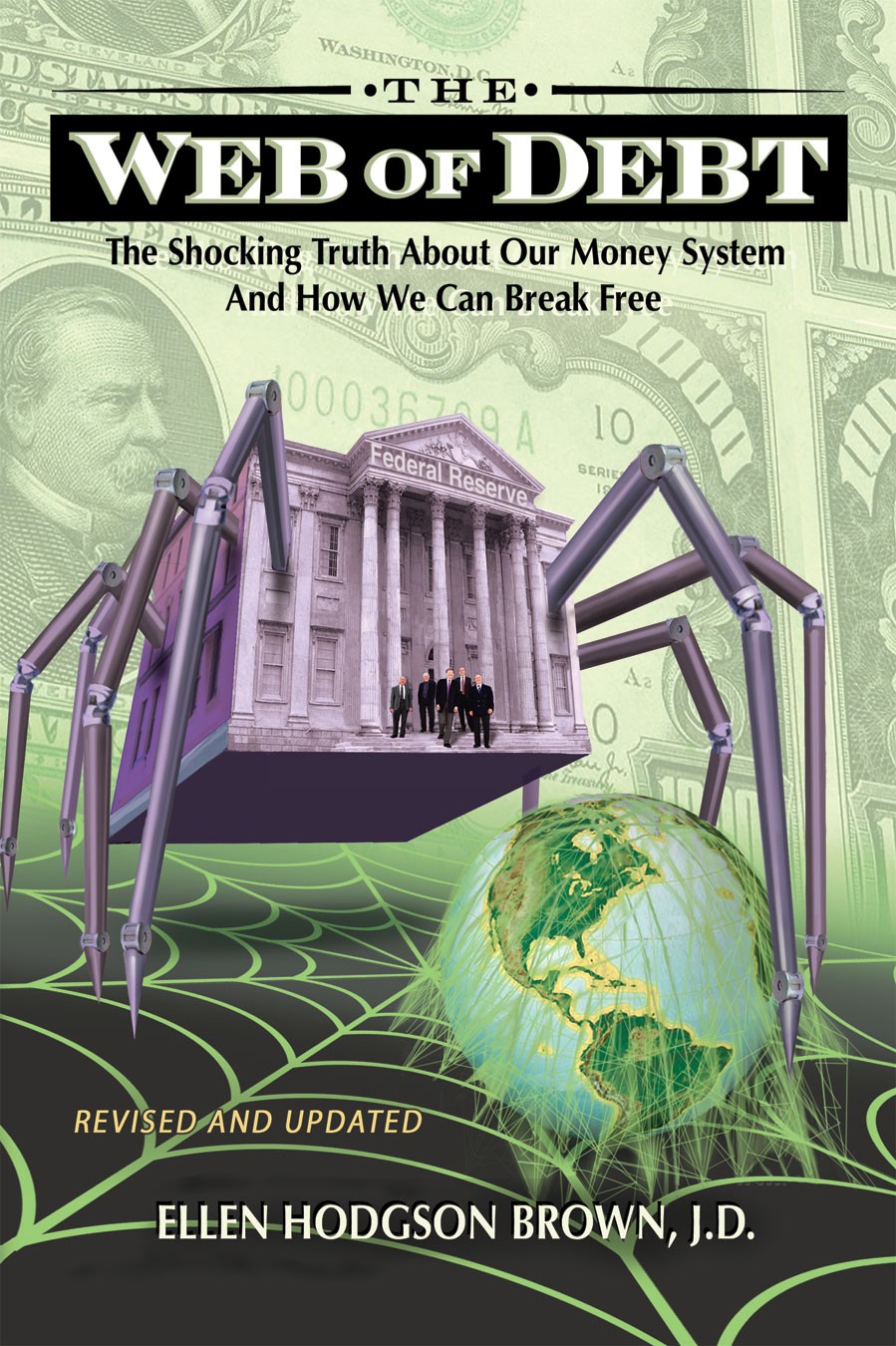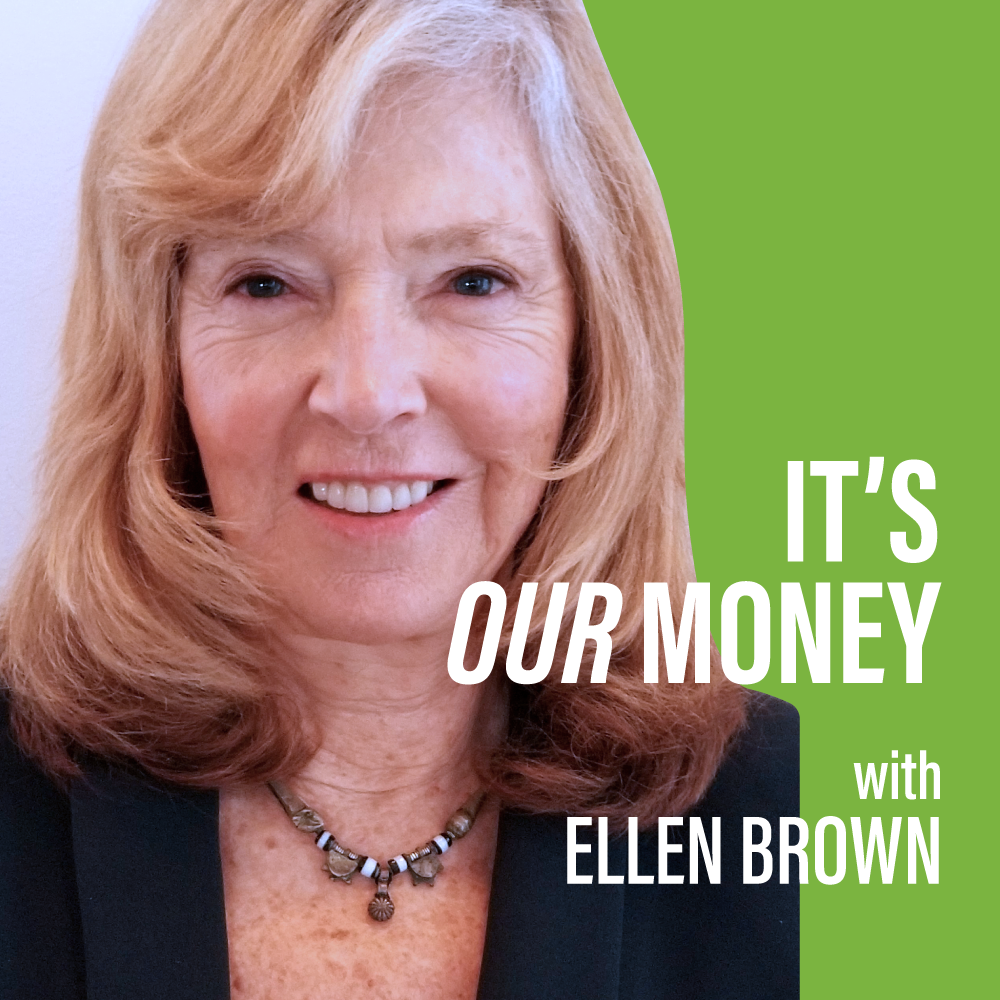While local banks are held in check by the new banking czars in Basel, Wall Street’s “shadow banking system” has hardly been curbed by regulators at all; and it is here that the 2008 credit crisis was actually precipitated. The banking system’s credit machine is systemically flawed and needs a radical overhaul.
Read more here –
http://www.webofdebt.com/articles/basel3_fail.php
Filed under: Ellen Brown Articles/Commentary |






[…] On September 13, the Bank for International Settlements issued heightened capital requirements that will make lending even more difficult for local banks, which do most of the consumer and small business lending today. The new rules are ostensibly designed to prevent a repeat of the 2008 credit collapse, but they fail to address its real cause, which involves a “shadow” banking system that has largely escaped regulation. What went wrong in September 2008 was not that the existing Basel II capital requirements were too low but that banks found a way around the rules. The Basel II rules base a bank’s capital requirement on how risky its loan book is, and banks can make their books look less risky by buying unregulated “insurance contracts” known as credit default swaps (CDS). This insurance, however, proved to be a fraud, when insurer AIG went bankrupt on September 15, 2008. The credit collapse that followed has normally been blamed on the collapse of the subprime housing market. But according to Yale economist Gary Gorton (whose views were recently embraced by Fed Chairman Ben Bernanke), the subprime problem was not itself sufficient to trigger a global credit freeze. What it did trigger was an old-fashioned bank run, in the not-so-familiar market known as the shadow banking system. (link to full article) […]
Ellen,
Have you ever considered running for Congress?
No, but thanks! I’m a writer.
You’re an excellent writer!
We need people in Congress to introduce legislation to make what you write about happen.
Maybe some of your readers will be inspired. I wish I had the nerve to run for Congress. Who out there has the nerve?
Ellen, In a month we will know the make up of our government. What can be done within the TEA PARTY movement to move to due something about our monetary system. God Bless You and yours
The 26% return to North Dakota from its own bank is very impressive, and not a little suspicious, too, if one thinks that a state owned bank in California, for example, could manage the same return on investment.
I don’t know the facts, but it seems probable that North Dakota, with a tiny population and huge land mass is temporarily benefiting from extraction of its non-renewable oil and mineral capital, which is being converted into easy profit for state bank bond holders, including the state itself. The state is not getting that kind of return on bushels of wheat.
I do not see how a state bank could, or should, have such hedge-fund-like returns on investment. Somebody pays that interest, the people or mother nature, or both. It is not sustainable.
I don’t believe a state bank should have the same charter as a commercial bank, that is, to make a profit. Our current crisis is a result of huge concentrations of private capital seeking ever greater returns, not from investment in the real economy, but from the derivative economy, the casino economy, the so-called shadow economy. Spectacular returns some hedge funds realize do not come from the productive enterprise of goods and services, but from paper profit, which is at the same time very real.insofar as it constitutes the available money supply.
A state bank can increase this money supply and counteract the deflationary effect of the casino economy, but not if it is chartered as a profit-making machine like any commercial bank. Its profit-making potential must reflect only real, sustainable growth, not bubble finance. If the real economy is growing at 1%, return on investment should be 1%. A state bank’s return on investment should be the general prosperity of the people in the state, the reduction of taxes, funding of public services, in short, the provisioning of the general welfare, not catering to the wishes of those who believe money should make money.
The truth is, money does not make money. Only people can make money. The only sustainable capital is the productive enterprise of the people.
I like the credit union model, where anyone who does business with the (non) bank owns between $5 and $1000 of it – nobody is allowed to own more than $1000, and nobody is allowed not to be an owner. If the (non) bank extracts a huge profit from its members, it goes right back to the members at the end of the year, so there’s no point. If there is a huge profit, it is at the expense of the same peolpe that realize the advantage of that profit, and that profit is spread thinly across all the members as dividends, deposit account bonuses, and loan rebates.
Credit unions exist under a business model that, by its nature, supports the community and its members while discouraging the accumulation of extreme wealth at the expense of others. The same of co-operative businesses in general.
I would like to see the obvious “too big to fail” bluff called. In Canada, we could suddenly treat fractional reserve banking as the illegal fraud that it is, and as the 5 big banks fall apart (yes, we only have 5), the credit union system could step up and fill the void. Combining money creation with a profit motive is inane, and very offensive to the intellect.
That sounds like a fine populist agenda to me!
Borrowing liberally from a previous post by Ellen, I submitted the following letter to the Minneapolis StarTribune. It appeared in print on 9/27. Online version is here: http://bit.ly/9RoUDd
BANKING RULES
Banks aren’t ‘tamed’ — they’re now entrenched
The commentary you ran in the business section from the Economist (“New rules aim to tame world banks,” Sept. 21) painted a too-reassuring picture of the new Basel III banking regulations.
The regulations, which increase capital reserve requirements for banks, do little or nothing to address the habits or financial soundness of the too-big-to-fail Wall Street giants. Those banks can easily meet the new requirements without adjusting their operations.
But smaller community banks will feel the pinch and will be forced to lend at higher rates and with stiffer terms to try to meet the higher reserve requirements.
The new regulations likely will accelerate failures among smaller banks, with the result that monetary control will become increasingly consolidated on Wall Street.
The commentary did not even name the regulatory body that issued the new requirements. It was the Bank for International Settlements in Basel, Switzerland, the “central bankers’ central bank.”
The new regulations are not the product of any legislative process that made its way through the U.S. Congress.
The regulations are the products of deliberations conducted behind closed doors by private international bankers.
The Bank for International Settlements operates on a global scale like our own Federal Reserve does in the United States, circumventing democratic institutions and procedures in setting monetary policy.
The new rules don’t “aim to tame world’s banks” as the commentary’s headline asserted. The new rules merely entrench the world’s biggest banks.
Excellent!
The crash of 2008 was fundamentally caused by the “shadow banking system” being able to use money borrowed short term from all over the world to invest long term and drive up real estate prices to unnatural and unsustainable levels. This bubble broke and ultimately led to a run (much like an old-fashioned bank run) when the shadow bankers were not able to roll over their short term funding. Then they required government bailouts to avoid bankruptcy. Turning short-term low interest borrowing into high interest long-term lending is like a magical money making machine while the game lasts. But the game is inherently unstable and society then pays the price both for the bailouts and the instability in prices and employment. As Martin Wolff of the Financial Times says: “The big point is that a financial structure characterised by short-term and relatively risk-free liabilities and longer-term and riskier assets is highly profitable, until it collapses, as it is rather likely to do.”
The real solution is to outlaw maturity mismatch in the entire financial system so that long term credit must be matched by long term liabilities. But in doing so we would also put an end to fractional reserve banking which is actually a “special case” of maturity mismatching because a demand deposit is actually an extemly short term loan of potentially zero duration.
When the banks can no longer create the money supply then the government can without creating runaway inflation.
Exactly! Brilliantly put! The repo market is just like a deposit account for big investors — it’s very short-term. The fundamental flaw is in the system itself. Investors and financiers will get around any regulations that are put in place by coming up with yet more shadow banking systems. Where the flaw is, as I see it, is with the notion that “credit” has to be “backed” with somebody else’s deposit at all. Credit is just your promise to pay later. I’m just writing about this: credit actually PRECEDED money historically. Hammurabi was dealing with accounting entries before they had coins. Credit is just trust: the community agrees to give you goods and services in return for your promise to assemble them in some useful way, allowing you to pay the trust back with interest or dividends. Credit should be a community function, kept track of by a public accountant, as in Hammurabi’s day. It’s a real struggle though figuring out how to present these concepts in an easily graspable way.
P.S. Where’s the Wolff article? I couldn’t find it. Thanks.
Ellen, I think one of the simplest ways of explaining how “money” should work is the way I use my Cash Rebate Credit Card. I pay off the entire balance every month, so it actually works like “money”, only it doesn’t cost me a dime. In fact I get around $500 in cash rebates every year. No fees, no interest, no cost to me, and I use it almost everywhere in place of money. It’s almost universally accepted, and where it isn’t I use a “fall back” card that also costs me nothing as long as I pay off the balance in full every month. This payment is done for me automatically through the electronic Bill Payment system at my bank. A actually see or use almost no actual “cash” or paper notes or coins at all nowadays. Its all computerized or electronic shifting of credits and debits.
So the credit card company is just acting as an “accounting agent” settling current financial transactions and balancing the books.
Of course they charge the merchants with a “transaction fee” but that is not my concern. My only concern is “keeping current” on my transactions and debt obligations.
Local communities could extend the same operations to their residents and merchants at far less “transaction fees” than the huge corporate credit card companies now do, and that savings could be passed on to the entire community.
Gold, silver, or other hard commodity “money” is redundant (not needed), only credit based on monthly income and reliability. A nearly cashless society is possible, as long as labor and production occur, and are in balance with obligations. That is all we really need, along with someone to assess credit-worthiness and keep the books.
Cheers, Jere
hi ellen
here is wolff article reference came from :
http://www.ft.com/cms/s/0/34cbca0c-ad28-11de-9caf-00144feabdc0.html
“Credit should be a community function, kept track of by a public accountant, as in Hammurabi’s day. It’s a real struggle though figuring out how to present these concepts in an easily graspable way.”
Exactly! Try and grasp the credit flow chart here… http://www.monetaryreform.com/MR/betterWay.htm
Great article, very informative. You also note that the fed is decreasing interest rate to near zero to help big banks do carry trade-borrowing dollar at zero and buying chinese bond that pays 5%, also trying to strengthen the chinese yuan vs the dollar, increasing the price of import, hurting us consumer even more.